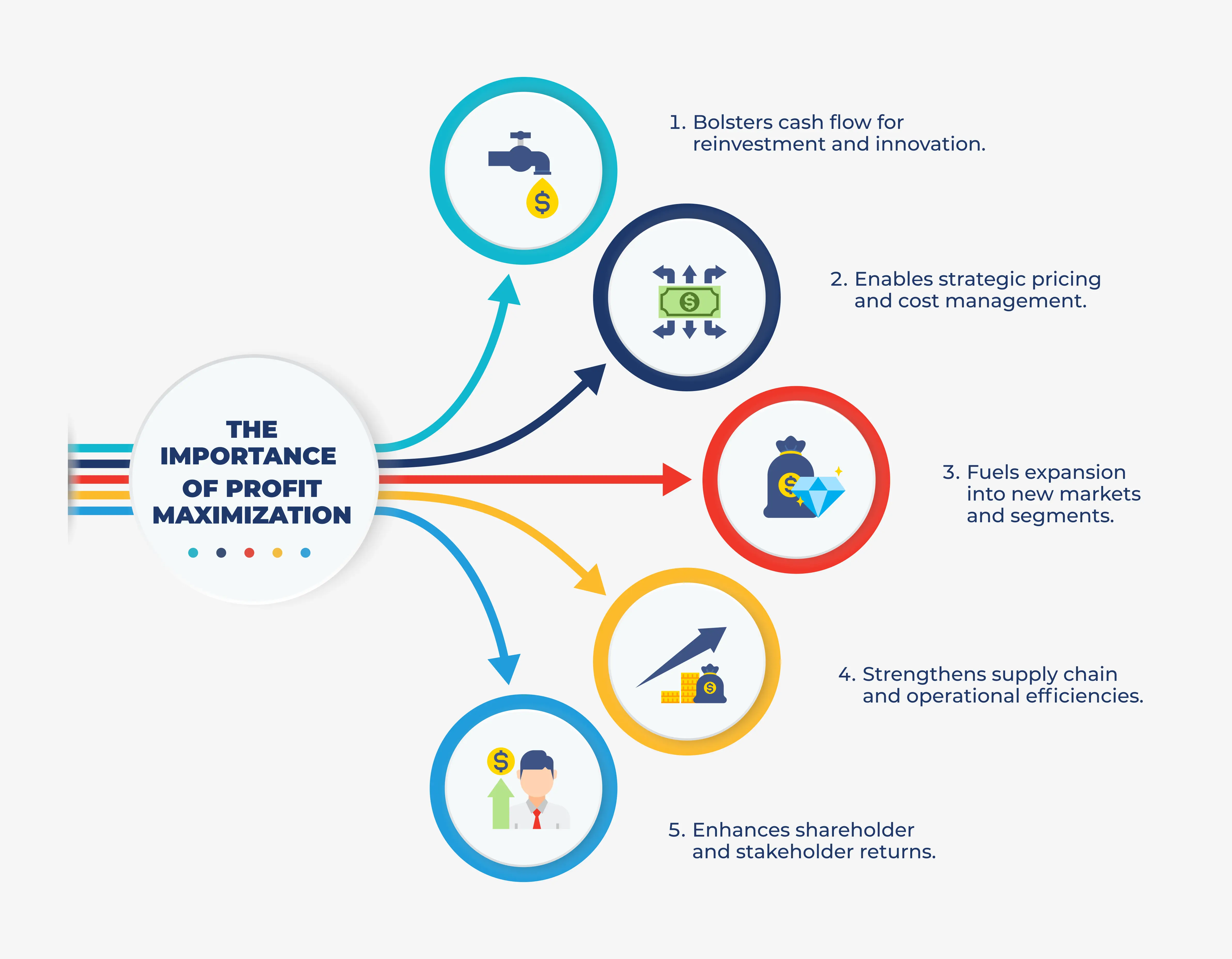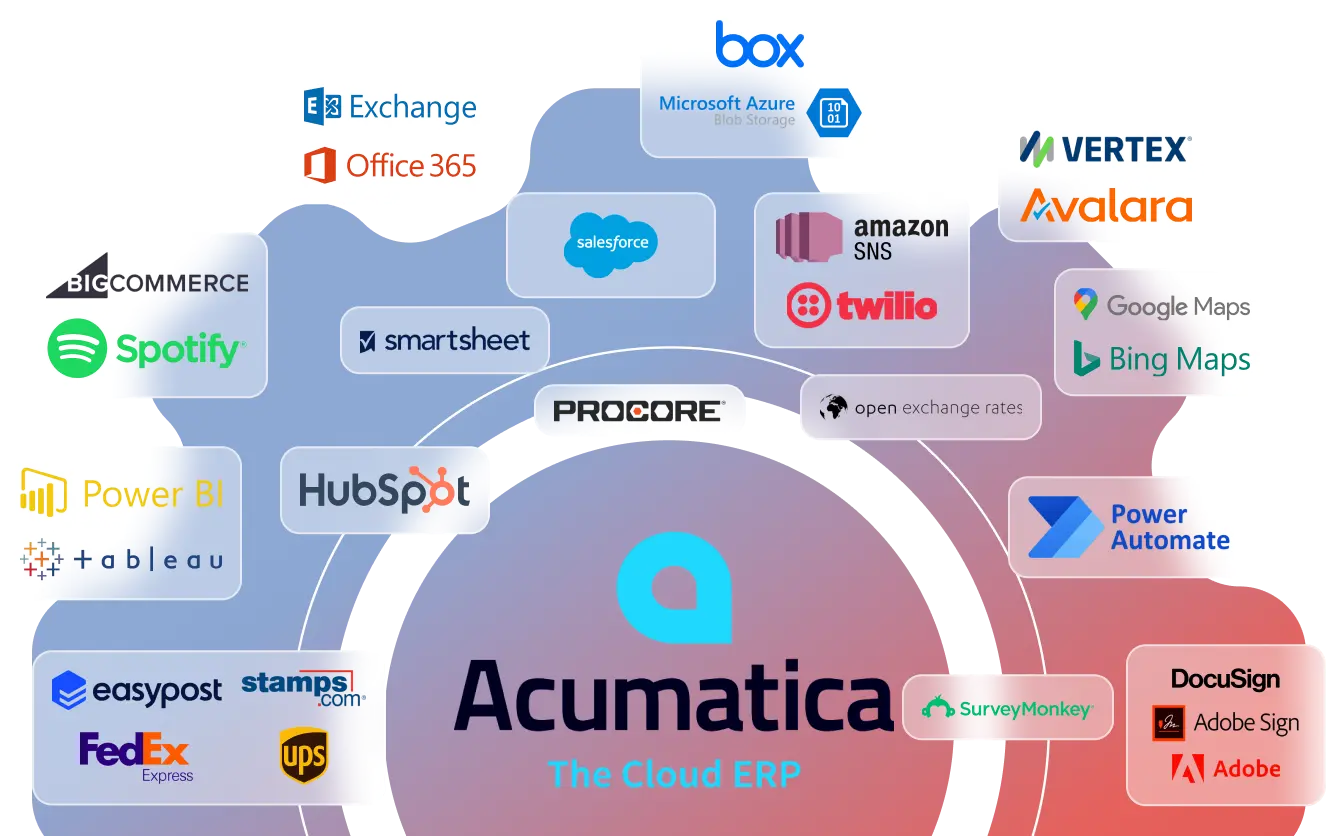
Profit Growth: What, How, Why and How Cloud ERP System Can Help
If you are in the distribution industry, you fight the battle for profit maximization on a daily basis. It's a reality where slim margins dictate strategy and operational efficiency can make or break your bottom line.
This article is aimed squarely at business owners, financial wizards, sales leaders, and operations experts who face these challenges every day. This article dives deep into the essence of profit maximization, offering you the insights and strategies you need not only to survive but thrive.
What is Profit Maximization?
The Concept
Profit maximization is the strategic calibration of your distribution operations to ensure peak efficiency and profitability. It involves a holistic approach, encompassing everything from refining pricing strategies and optimizing sales avenues to streamlining every operational nuance. The objective is clear: to ensure that the financial outcomes of these activities collectively push your profit margins to their maximum potential.
Imagine a scenario where each operational component, whether it's inventory management, logistics, customer service, or sales, is a cog in a larger machine. Profit maximization ensures that each cog is well-oiled and turning in perfect synchrony to drive the machine forward effectively. It's about employing data-driven pricing models, automating inventory to reduce holding costs, and leveraging customer insights to foster loyalty and repeat business.
Its Importance
Why do distribution companies zero in on profit maximization? The answer lies in the fundamental goal of not just surviving the competitive pressures but thriving to achieve business expansion and resilience. It's about crafting a fortress of financial health that empowers your business to invest in new technologies, break into new markets, and sustain operations through economic fluctuations.
In essence, profit maximization is not merely a financial objective; it's a strategic imperative that underpins the long-term sustainability and growth potential of your distribution business. It ensures that you're not just reacting to the market but proactively shaping your future within it.

Navigating Profit Maximization in Distribution: A Tactical Approach
In the distribution business, where margins are tight and competition is high, understanding how to maximize profit is crucial. It boils down to a simple formula:
Profit = Total Revenue - Total Cost.
This basic principle guides every strategic move, from pricing to operations.
Marginal Analysis: Your Guide to Profitability
Marginal analysis might sound complex, but it's really about making sure the revenue from selling one more item is equal to its cost. It tells us the best amount to sell to make the most profit. Think of it as finding the sweet spot where you're making the most money without overspending to do so.
Applying This in Real Life
What does this mean for your day-to-day operations? It means being smart with your pricing, adjusting it based on what's happening in the market and how much stock you have. It's about keeping an eye on your inventory to make sure you're not stocking too much or too little. And it's about being flexible and ready to change your strategy based on new information.
Cost Management: More Than Just Saving Money
Managing your costs is about making smart investments that pay off in the long run. This could mean automating parts of your warehouse to save on labor costs or using software to better manage your sales and operations. It's not just about spending less; it's about spending wisely.
Why It Matters
For those running distribution companies, these aren't just nice ideas—they're essential practices. They're about ensuring your business isn't just getting by but actually thriving. It's making sure every decision you make today puts you in a better position for tomorrow.
In a nutshell, maximizing profit in distribution is about making informed, strategic decisions that keep your business lean and competitive. It's about knowing your numbers, understanding your market, and being ready to adapt. That's how you not only survive in this industry but succeed.
The Profit Diamond Framework
David S. Bauders, CEO of SPARXiQ, has a really informative article on NAW’s website where he explains the Profit Diamond Framework with examples and clear elaboration. If you want to read what it is and its value, we are leaving a link for you.
Who is Responsible for Profit Growth?
In the distribution industry, achieving profit growth is a team effort, but specific roles have significant impacts on driving profitability. Let's get straight to the point on who plays a crucial role and how.
Leadership's Role
First up, leadership - the business owners and directors. Their job is to craft the vision and strategies that guide the company toward higher profitability. They decide where to invest, identify which technologies can streamline operations, and ensure that every department is aligned with the company's financial goals. Essentially, they lay down the tracks for the company's journey toward profit maximization.
Sales and Operations
The sales and operations teams are where strategies are implemented. Sales professionals focus on generating revenue, understanding customer needs, and effectively marketing the company's products. Their ability to adapt pricing strategies and maintain strong customer relationships directly influences the company's revenue streams.
On the other side, the operations team ensures that the company's day-to-day activities run smoothly. From managing inventory to optimizing the supply chain, their efforts are vital in reducing costs and improving margins. Efficient operations mean the company can deliver on its promises to customers while keeping costs in check.
Finance Department
Lastly, the finance department. They're the analytical backbone of the company, providing the data and insights needed for informed decision-making. By overseeing financial planning, budgeting, and analysis, the finance team ensures that resources are used efficiently and that financial targets are met. They monitor cash flow, analyze financial performance, and advise on financial strategies to sustain and grow profits.
In reality, profit growth in the distribution industry comes down to a collaborative effort across all these key areas. Leadership provides the direction, sales and operations execute the plan, and finance ensures the strategy is financially sound. Together, they form a cohesive strategy focused on driving profitability, grounded in realistic and practical approaches to business management.
Main Strategies for Maximizing Profitability
Here are some proven strategies for enhancing your company's bottom line:
Strategic Pricing
Adopting dynamic pricing strategies is crucial. This means adjusting your prices based on market demand and what your competitors are doing. It's not about undercutting the competition at every turn but finding the value your customers are willing to pay for and pricing accordingly. This approach requires a keen understanding of the market and the flexibility to adjust prices as conditions change.
Efficiency in Operations
There's a direct link between operational efficiency and profitability. Implementing automation in key areas of your business, from inventory management to order fulfillment, can significantly reduce manual errors and labor costs. Additionally, optimizing your supply chain to ensure goods move more efficiently from suppliers to customers not only cuts costs but also improves customer satisfaction. Don't overlook waste reduction; eliminating inefficiencies in your operations can lead to substantial cost savings.
Expansion and Diversification
Growing your business often means looking beyond your current markets and product lines. Exploring new markets can open up additional revenue streams and reduce dependence on a single market or customer base. Similarly, diversifying your product lines to include complementary products or services can capture a larger share of your customers' wallets. This strategy requires careful market research and an understanding of your company's core competencies.
Customer-Centric Approach
Lastly, a customer-centric approach is key to maximizing profitability. This means going beyond just meeting customer expectations to truly engaging with your customers and building loyalty. Implement strategies that enhance customer lifetime value, such as personalized service, loyalty programs, and proactive customer support. Happy, engaged customers are more likely to become repeat buyers and advocates for your brand, driving both sales and profitability.

How Cloud ERP System Can Help in Profit Maximization
Maximizing profit in today’s distribution industry means making every process leaner, every decision faster, and every customer interaction count. Here’s where a cloud ERP system becomes more than just software—it’s your strategic partner in achieving these goals.
Tailored Pricing Strategies
Dynamic pricing is key in staying competitive while safeguarding your margins. A cloud ERP system brings the power of real-time data to your fingertips, allowing you to adjust pricing based on market demand and competitor activity. This level of agility ensures you're always positioned attractively in the market without eroding your profits.
Streamlining Operations
Operational efficiency is the backbone of profitability. With a cloud ERP, automation takes center stage—simplifying inventory management, speeding up order processing, and reducing manual errors. It’s about doing more with less, ensuring that your operations contribute positively to your bottom line without the need for constant oversight.
Exploring New Horizons
Growth often means venturing into new markets or broadening your product lineup. Cloud ERP systems are designed for scalability, supporting you as you expand without the growing pains. They make managing additional product lines and entering new markets smoother by handling increased order volumes and offering integration with e-commerce platforms and other sales channels.
Putting Customers First
At the end of the day, your customers determine your success. Cloud ERPs help you understand your customers better by tracking interactions and consolidating data across all touchpoints. This insight allows for more personalized service, timely engagement, and proactive problem-solving—key factors in building loyalty and encouraging repeat business.
Things to be aware of about Cloud ERP
Implementing a cloud ERP system can be a transformative step for your business, offering a pathway to optimized operations and enhanced profitability. However, to truly capitalize on this technology, there are crucial considerations every business leader should be aware of:
Aligning with Business Needs
Selecting the right cloud ERP system starts with a clear understanding of your business requirements. Not all ERPs are created equal; each comes with its own set of features, strengths, and limitations. Assess how well a system can:
- Support your specific industry requirements.
- Scale with your business growth.
- Offer customization to fit unique aspects of your operations.
It’s about finding a solution that meets your current needs and can support your future growth ambitions.
We have a checklist that can help you with comparing three different ERP systems. It has five criteria:
- Productivity
- Functionality
- Technology
- Value
- Risk
You can also set there your priorities for this or that criteria.
You can also read our article where we compare Acumatica ERP to 9 other ERP systems. Not very objective, we agree. But it's still worth your time.
Ensuring Seamless Integration
The value of a cloud ERP system significantly depends on its ability to work harmoniously with your existing digital infrastructure. Seamless integration means:
- Minimal disruption to current operations during the transition phase.
- The ability to synchronize data across all your business functions, from sales and customer relationship management to supply chain and finance.
- Reducing the need for manual data entry and the risk of errors that come with it.
Before committing, verify the ERP's compatibility with your existing systems and ensure it supports integrations with any specialized software critical to your operations.
When companies choose Acumatica among other ERP systems, the question of integration isn’t a big deal. Acumatica has over 260 integrations covering financial operations, shipping, CRM, inventory management, and more. You can see all of them on Acumatica’s website.

In case you don’t see the integration you need, our AcuPower team can develop any integration or tracking tool you need to match your workflows and needs.
For instance, we have developed a chat GPT integration with Acumatica that automates data analysis and lets your support team provide detailed and personalized responses to your customers much more quickly. The boost in customer loyalty is the result of it.
Learn more about this integration on our product page or watch our demo videos on our YouTube channel.
Investing in Training
The most advanced cloud ERP system won’t deliver on its promise without a team capable of leveraging its features. Comprehensive training is essential to ensure:
- Users are comfortable and proficient with the system.
- Your team can exploit the ERP’s full range of functionalities to support your business objectives.
- Reduce resistance to change by demonstrating the system’s value and easing the transition from old processes.
Consider the ERP vendor’s training support and look for solutions that offer accessible learning resources for ongoing education.
When you partner with us, our team provides all the documentation and training you need to use Acumatica effectively. We also publish tutorials on our YouTube channel. Make sure to subscribe.
Monitoring and Adapting
The implementation of a cloud ERP system is not a one-and-done deal. Continuous monitoring and adaptation are key to realizing its full potential for profit maximization. Utilize the system’s analytics tools to:
- Track performance against key business metrics.
- Identify areas for operational improvement.
- Adjust strategies in response to real-time insights provided by the ERP.
This approach ensures your ERP system remains a dynamic tool that evolves in line with your business strategies and market demands.
In wrapping up our discussion, it's clear that the journey to maximizing profits in the distribution world is multifaceted. We've walked through the importance of adapting your pricing, making your operations as efficient as possible, venturing into new markets, and always putting your customers first.
Equally, we've seen how a cloud ERP system can be the backbone of these efforts, giving you the real-time data and operational agility you need. For those of you leading the charge—business owners, financial heads, sales and operations managers — embracing these strategies and tools isn't just a good idea; it's essential. It's about making smart, informed decisions that keep your business moving forward, growing stronger, and staying competitive.
Here's to not just navigating the challenges of the distribution industry but mastering them for your company's success.
Comments (0)
No comments yet
Be the first to comment
 Share on Facebook
Share on Facebook
 Share on LinkedIn
Share on LinkedIn
 Share on Twitter
Share on Twitter





 1353
1353

